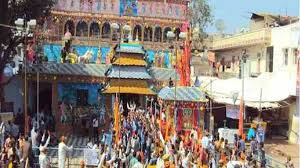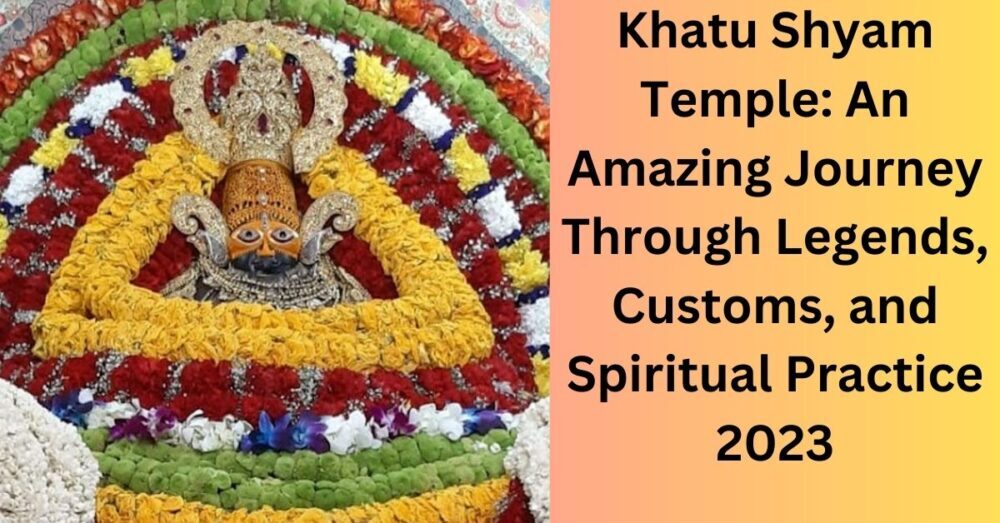Welcome to the mystical world of Khatu Shyam Temple, a renowned pilgrimage site nestled in the heart of Rajasthan, India. This ancient temple holds not only architectural splendor but also a rich tapestry of legends, customs, and spiritual practices that have captivated devotees for centuries.
Join us on a spiritual journey as we delve into the captivating mythology surrounding Khatu Shyamji, explore the unique customs and rituals practiced at the temple, and uncover the spiritual significance of this sacred place in modern times. Embark on an enchanting pilgrimage to discover the divine charms of Khatu Shyam Temple like never before.

Contents
- 1 The Legend of Khatu Shyamji in Hindu Mythology
- 2 The Enchanting Architecture of the khatu shyam Temple
- 3 Rituals and Customs at Khatu Shyam Temple
- 4 Spiritual Significance of Khatu Shyam Temple in Modern Times
- 5 Meera Bai’s Connection to the Temple: A Devotee’s Tale
- 6 How to Reach Khatu Shyam Temple: Travel Tips and More
The Legend of Khatu Shyamji in Hindu Mythology
According to Hindu mythology, Khatu Shyamji is a revered deity who is worshiped as a form of Lord Krishna. As per legend, Khatu Shyamji appeared in the village of Khatu as a young boy with dark blue skin and a peacock feather on his head.
The story goes that he was found by a cowherd who brought him home and raised him as his own son. As the boy grew up, he began performing miracles and showing signs of divinity.
One day, Lord Krishna appeared to the cowherd in a dream and revealed his true identity as Khatu Shyamji. He instructed the cowherd to build a temple in his honor at the spot where he had first appeared. The cowherd did as he was instructed, and the temple of Khatu Shyam was built on the site.
Khatu Shyamji is also associated with the legend of Barbarika, a warrior who was the grandson of Bhima, one of the Pandavas. Barbarika was known for his exceptional archery skills and was said to possess three divine arrows that could destroy the entire universe. However, Lord Krishna appeared to him and asked him to sacrifice his head as a test of his devotion. Barbarika agreed and offered his head to Lord Krishna. Lord Krishna was pleased with his devotion and granted him a boon that his head would remain alive and continue to witness his glory in the Kali Yuga.
It is believed that the head of Barbarika is enshrined in the temple of Khatu Shyam as a form of Lord Shyamji. The legend of Khatu Shyamji in Hindu mythology is a significant part of the temple’s history and adds to its spiritual significance. The temple is considered to be a sacred site for devotees of Lord Krishna and his various forms.
The Enchanting Architecture of the khatu shyam Temple
The Khatu Shyam Temple in Rajasthan, India is not just known for its rich history and legends but also for its enchanting architecture. The temple’s design is a perfect blend of Rajasthani and Mughal architectural styles, making it a unique masterpiece.
The temple’s main entrance is called the Mahadwar and is made of white marble with intricate carvings and designs. As one enters, the temple’s courtyard or sabha mandap, which is built in Rajasthani style, comes into view. The sabha mandap has four pillared halls with intricately carved pillars and arches that are adorned with beautiful paintings and frescoes.
The temple’s sanctum sanctorum or garbhagriha is built in the Mughal architectural style, with a marble dome and minarets. The walls of the garbhagriha are adorned with intricate carvings and paintings of Lord Shyamji and other deities.
The temple’s unique architecture also includes a beautiful water tank or kund called Shyam Kund, which is believed to have healing properties. The kund has steps on all four sides and is surrounded by beautiful carvings and sculptures.
Overall, the Khatu Shyam Temple’s enchanting architecture is a feast for the eyes and adds to the temple’s spiritual significance. It is a perfect blend of Rajasthani and Mughal architectural styles and is a testament to the rich cultural heritage of India.
Rituals and Customs at Khatu Shyam Temple
Here are some of the rituals and customs followed at the Khatu Shyam Temple:
- Darshan: Devotees start their visit by taking darshan, which means seeing the deity, at the temple’s sanctum sanctorum or garbhagriha. The idol of Lord Shyamji is adorned with clothes, flowers, and other offerings.
- Aarti: The aarti ceremony is performed twice a day, once in the morning and once in the evening. The aarti is a ritual where devotees offer prayers to Lord Shyamji and seek his blessings. It is accompanied by the sound of bells, conch shells, and drums.
- Prasad: Devotees can offer prasad, which is a sweet or savory food item, to Lord Shyamji. The prasad is then distributed among the devotees as a blessed food item.
- Circumambulation: Devotees perform a circumambulation or parikrama around the temple, which is a ritual of walking around the temple’s perimeter in a clockwise direction.
- Donations: Devotees can donate money or other items to the temple as a form of offering to Lord Shyamji. The donations are used for the maintenance and upkeep of the temple.
- Holy Dip: Devotees can take a holy dip in the Shyam Kund, a water tank located inside the temple premises. It is believed that taking a dip in the Shyam Kund can cure ailments and bring good health.
Overall, the rituals and customs followed at the Khatu Shyam Temple are a testament to the deep-seated faith and devotion of the temple’s devotees. They add to the spiritual significance of the temple and make it a must-visit site for anyone seeking a spiritual experience.
Spiritual Significance of Khatu Shyam Temple in Modern Times
The Khatu Shyam Temple holds great spiritual significance for devotees of Lord Shyamji, particularly in modern times. The temple is believed to be a source of spiritual energy and a place where devotees can connect with the divine.
Devotees from all over the world come to the temple to offer their prayers and seek blessings from Lord Shyamji. The temple is particularly popular among those seeking success and prosperity in their personal and professional lives. It is believed that offering prayers and performing rituals at the temple can bring good luck and fulfillment of wishes.
The temple also serves as a center for spiritual and cultural activities. Various festivals and events are organized throughout the year, including the annual Shyam Baba Mela which attracts thousands of devotees. The temple complex also includes a library and a museum which houses ancient scriptures and artifacts related to Hindu mythology.
Overall, the Khatu Shyam Temple is a symbol of devotion and spirituality, and continues to hold great significance for devotees seeking to connect with the divine and enrich their spiritual lives.
Meera Bai’s Connection to the Temple: A Devotee’s Tale
Meera Bai, a 16th-century saint and poetess, is known for her devotion to Lord Krishna and is considered one of the most significant figures of the Bhakti movement. Her connection to the Khatu Shyam Temple is a story of deep devotion and spiritual connection.
Legend has it that Meera Bai, who was a devotee of Lord Krishna, had a vision of Lord Shyamji at the temple in Khatu. She was so moved by the experience that she composed several bhajans (devotional songs) in honor of Lord Shyamji. Her songs, which were full of passion and devotion, became popular among the devotees of the temple and are still sung today.
Meera Bai’s connection to the temple is also reflected in the temple’s architecture. The main entrance of the temple is known as the ‘Meera Dwar’and there is a small room within the temple complex known as the ‘Meera Mandir’, which is dedicated to her memory.
The temple continues to inspire devotees to connect with the divine and enrich their spiritual lives. Meera Bai’s devotion and connection to the temple serve as a reminder of the power of faith and the enduring legacy of the Bhakti movement.
How to Reach Khatu Shyam Temple: Travel Tips and More
Khatu Shyam Temple is located in the small town of Khatu in the Sikar district of Rajasthan, India. The temple is a popular pilgrimage site and attracts thousands of devotees from all over the country. Here are some tips on how to reach Khatu Shyam Temple and make the most of your visit.
By Air: The nearest airport to Khatu Shyam Temple is Jaipur International Airport, which is located approximately 100 km away. From the airport, you can take a taxi or hire a car to reach the temple.
By Train: The nearest railway station to Khatu Shyam Temple is Ringas Junction, which is well-connected to major cities in Rajasthan and other parts of the country. From the railway station, you can take a taxi or hire a car to reach the temple.
By Road: Khatu is well-connected by road to major cities in Rajasthan, including Jaipur, Jodhpur, and Bikaner. You can take a bus or hire a taxi to reach the temple from these cities.
Once you reach Khatu, the temple is easily accessible by foot or by rickshaw from the town center. The temple complex has several guest houses and dharamshalas where you can stay and immerse yourself in the spiritual atmosphere of the temple.
Khatu Shyam Temple Timing
The temple timings vary according to the season and the day of the week. Here is a table summarizing the timings:
| Season | Morning | Evening | Closed on | | Winter | 5:30 AM to 1:00 PM | 5:00 PM to 9:00 PM | Sunday, Shukla Paksha Ekadashi & Dwadashi | | Summer | 4:30 AM to 12:30 PM | 4:00 PM to 10:00 PM | Sunday, Shukla Paksha Ekadashi & Dwadashi |
The temple also has different aarti timings for winter and summer seasons.
| Season | Mangala Aarti | Pratah or Shringar Aarti | Bhog Aarti | Sandhya Aarti | Shayan Aarti | | Winter | 5:30 AM | 8:00 AM | 12:30 PM | 6:30 PM | 9:00 PM | | Summer | 4:30 AM | 7:00 AM | 12:30 PM | 7:30 PM | 10:00 PM |
The temple is open for 24 hours on Shukla Paksha Ekadashi and during the Phalgun Mela. The temple also requires online registration for darshan due to COVID-19 guidelines
Khatu Railway Station to Khatu Shyam Temple Distance
The distance between Khatu Railway Station and Khatu Shyam Temple is about 17 km. You can take a taxi, auto-rickshaw or bus from the railway station to reach the temple. The travel time is about 35 to 40 minutes.
Ringas to Khatu Shyam Temple Distance
The distance between Ringas and Khatu Shyam Temple is about 17 to 18 km. You can take a taxi, auto-rickshaw or bus from Ringas to reach the temple. The travel time is about half an hour.
When visiting the temple, it is important to dress modestly and follow the customs and traditions of the temple. Devotees can participate in the daily rituals and offerings made to the deity and seek blessings for themselves and their loved ones.
Overall, a visit to Khatu Shyam Temple is a spiritual and cultural experience that should not be missed by anyone traveling to Rajasthan. With proper planning and preparation, you can make the most of your visit and return with memories that will last a lifetime.
Read More – Rajasthan’s Top 10 Tourist Hotspots: Uncovering the Magic of the Land of Kings
